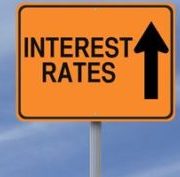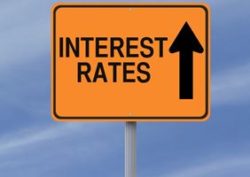The Death of the High Yield Investment
Interest rates have been going down for so long that you have to be as old as I am (66) to remember what interest rate??risk is.
Despite more than $200 billion worth of inflows into bond funds in 2017, most delivered total returns of near zero.
Now get ready for the shocker: 2018 will be the first time in three decades where bond investors see actual LOSSES!
For the fat is about to hit the fire. Sometime in 2018 both the Federal Reserve AND the European Central Bank will be engaged in quantitative tightening at the same time. You can almost hear that great sucking sound already.
Which begs the question, after visiting this well for so long, what are investors in traditional high yield plays supposed to do during a period of consistently rising interest rates?
It is a conundrum.
The writing is certainly on the wall. Since the beginning of this year the yield on the ten-year Treasury bond has erupted from 2.41% to 2.74%.
Our double short position in bonds (TLT) has been the most consistently profitable trade so far in 2018. It has been a true rout for the ages.
No matter where you look in fixed income land, be it ten-year Treasury bonds, corporates, and the 30-year conventional fixed rate mortgage, rates have just blasted through to four-year highs.
Do not give up all hope. There are a number of ways fixed income players can earn their crust of bread in a rising rate market, but you may have to go to a natural history museum to find them. When was the last time someone recommended you buy TIPS (Treasury Inflation Protected Securities)? The Jurassic Period?
Also, some of these instruments are anything but plain vanilla and may require more than the usual amount of due diligence.
The principal goal for bond holders in a rising rate environment is to protect their principal through shortening duration. A six month or one-year maturity will carry infinitely lower risk than a 10 or 30 year one.
It the wheels fall off the debt market, and they are in the process of doing exactly that, you just collect your interest and principal when the paper matures and be gone.
Another big priority is to shift from fixed rate bonds to floating rate ones. This way, the bond's interest payments rise with interest rates, thus protecting the value of the underlying principal.
Some 30 years ago, the last time interest rates were rising, there was an entire cottage industry devoted to issuing and analyzing just such instruments. Now it is a shadow of its former self. But there are still a few around and I will try to analyze them for you one by one.
TIPS-
The total return on Treasury Inflation Protected Securities is tied to the Consumer Price Index. When inflation rises, the value of your TIPS rise.
The problem now is that while interest rates are rising sharply, inflation is moving at a snail's pace, so no protection here. When it does, your TIPS should perform.
Junk Bonds-
Buying the junk bond ETF's like (JNK) and (HYG) has been a traditional means through which investors reached for yield. Unfortunately, they have so closely tracked the stock market in recent year they now offer no downside protect from a stock market rout.
They are also just as overvalued as shares, with the average junk yield of 5.2% now at a record low, some 246 basis points over ten-year Treasury bonds. Better to stay away in droves.
REITS-
Real Estate Investment Trusts have been a perennial high yielders favorite. However, these are highly leveraged entities, so when their cost of money rises they take a big hit. This is why I have been begging readers to bail on their REIT's for the past year.
However, there are still a few specialized REIT's that make sense. REIT's that invest predominantly in floating rate securities possess the tax advantages of normal REIT's but lack the principal risk.
One of these is Great Ajax (AJX), which invests in pools of mortgage securities, and boasts an 8.6% dividend yield. Because REIT's generally are so out of favor you can buy this at a 10% discount to net asset value. Chimera Investment (CIM) has a similar set up.
Taxable Municipal Bonds-
We all know the wonders of tax free local municipal bonds. However, in a falling tax rate environment this are much less valuable than in the past.
In that case you want to move to taxable municipal bonds which offer much higher yields.
The great thing here is that even taxable muni bonds have far lower default rates than normal corporate bonds which aren't reflected in the yields.
And you can sidestep the taxability by only holding the securities in one of your tax-free retirement accounts, of which I'm sure you all have many.
The PowerShares Taxable Municipal Bond Portfolio (BAB) has a 4% yield and a portfolio of single "A" to double "AA" munis, which is really the same as having a triple "AAA" corporate bond portfolio.
What about Puerto Rico debt you may ask, which we all know will never repay all its debts? You can buy such paper, but only if it is insured, which still leaves you a reasonable 4.5% return net of expenses.
Master Limited Partnerships-
With the price of oil expected to remain stable or rise for the next year, an MLP is a pretty good way to reap some safe double digit returns.
MLP's take advantage of specialized tax breaks unique to their industry that allow you to avoid double taxation of corporate profits and dividend payouts, thus offering much higher returns than normal companies.
The catch is that as partnerships you must include a form k-1 with your tax return for each one of these you own. If you have a lot your return will start to look like the New York telephone book (if they still have those) or Sears catalogue (oops, they're gone too).
Here, the research really pays off. Knowing the quality of the assets underlying each partnership is immensely valuable. I'll give you three good ones: Enterprise Products Partners (EPD), Magellan Midstream Partners (MMP), and NuStar Energy (NS). If you'd rather avoid the tedium of k-1's you can go with Kinder Morgan (KMI) or Oneok (OKE).
However, if oil goes into a swan dive again, as it will in the next recession, you don't want to be anywhere near the MLP space. Many of these went bankrupt in the last down cycle (remember LINN)?
Business Development Companies-
BDC's are securitized direct lenders to small and medium sized businesses. This is a great business model because you can lend at very high 8%-10% interest rates to mezzanine level companies, while getting almost unlimited access to their books to quantify your risk. Most of these loans are extended with floating rates, mitigating your interest rate risk
WhiteHorse Finance (WHF) is in this business, as is OFS Capital (OFS). The trick is to avoid BDC's the concentrate too much risk with a single borrower. You also want to avoid this business when we go into a real recession. Many of these drop like flies during the last turn down, although that was a once in a century event.






